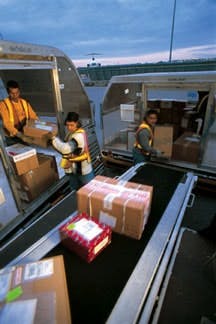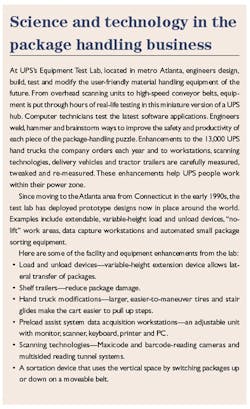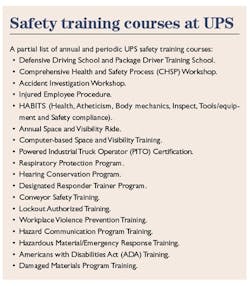A good safety plan is greater than the sum of its parts
The word holistic, appropriately or not, has been used to define an approach to everything from health food or achieving Nirvana. Basically, in a holistic approach, several components work together to achieve a result that is greater than the sum of its parts. It seems an odd term to use in association with workers' health and safety, but it's spot on.
Safety has a lot to do with having the right equipment, using proper methods and developing the right attitude. It's all of those things, but it's also a lot more. You might say that protecting employees' health and safety requires attention to the "complete package" of training, awareness and engineering.
Moving the worldone package at a time
At UPS, we move more than 13 million packages and documents a day. Efforts to improve efficiency while protecting workers health and safety involve thousands of people across the organization. Safety is a part of our culture. In fact, keeping people safe is one of the primary components of our charter.
UPS employs 360,000 people who serve eight million customers a day. We operate the 11th largest airline in the world. Each year, 88,000 drivers ply the streets, racking up two billion road miles. We operate in more than 1,500 domestic facilities.
On a daily basis, we handle six percent of the nation's gross domestic product. We know full well there's no such thing as a virtual package. Someone, somewhere must travel that last mile.
Moving millions of packages around the world is, by definition, a physical job. You're still more likely to find a UPS employee driving a package car or sorting packages in a bustling hub than behind a desk.
With that in mind, I hope some of the ways we keep workers safe can spark some ideas you can use to protect and improve your employees' safety and productivity.
The bedrock of our safety efforts is training, and our own version of the safety committee is the Comprehensive Health and Safety Process, or CHSP.
Training: the cornerstone of safety
The foundation of everything we do is training. We spend $38 million a year on safety training. More than 350 safety professionals are responsible for the safety of our frontline people. Through 26 formal safety courses, our people receive more than 1.2 million hours of safety training annually.
That training starts the day a new employee walks in the door. Initial and recurrent training includes the cornerstone of our effortsHABITS, which stands for Health, Athleticism, Body mechanics, Inspect, Tools/equipment and Safety compliance.
HABITS begins with health education to explain the basics of body structure and function, nutrition and exercise and why safe work methods are important. It explains the benefits of proper conditioning and mental readiness for every task. It instructs employees about lifestyle choices that affect health. HABITS training uses the latest techniques in proper body mechanics to increase comfort and reduce fatigue. It concludes with the proper handling of hazardous materials and government regulations.
Among the fundamentals of HABITS is teaching employees how to lift and lower packages, pivot feet instead of twisting and how to keep packages in their "power zone," the area between the shoulders and knuckles.
Letting employees take ownership
After training, the next component is awareness achieved through the Comprehensive Health and Safety Process, or CHSP, a system developed in 1995 to protect and improve employee health and safety.
Since 1998, the number of workdays lost through injury has declined by 50 percent, and CHSP is the primary reason for that decline. Each of the 2,400 CHSP committees in the U.S. consists of drivers and package handlers, supported by a management co-chair, who together conduct facility and equipment audits, perform work practice and behavior analysis, conduct training and recommend work process and equip-ment changes.
The key to CHSP success and the fundamental difference between it and other safety committees is empowerment. By letting employees take ownership of the safety process, they become passionate advocates for a healthy and safe environment.
The hourly employees on these committees are no longer "told" what to do. Instead, they are given the tools they need to drive change in the workplace. The management co-leaders attend monthly meetings and assist with training, but primarily give the committees any support they need. After all, who better to look at job setup, facility design and injury analysis than the people who do the job? That's why CHSP works so wellour frontline service providers have taken ownership of their coworkers' health and safety.
Human factors and engineering
We believe that employees can be efficient and safe at the same time. Our methods and engineering approach simultaneously addresses productivity and safety. In fact, we've found that employees who use safe work methods are naturally more productive.
Our definition of "human factors engineering" is designing and analyzing the workplace to enhance our people's effectiveness and comfort by identifying job improvement opportunities and using cross-functional consultation. Our industrial engineers individualize the workplace by addressing the physical and cognitive characteristics, capabilities and limitations of individuals, using research and anthropom-etry, biomechanics, physiology and psychology.
Human factors bring the work closer to the person, keep it in the person's power zone and make the environment and equipment as user-friendly as possibleall driven by an understanding of what makes an individual tick. Human factors have identified and implemented more than 40 design improvements to our facilities, vehicles and equipment.
The company has spent billions on state-of-the-art automation technology to reduce the need for employees to touch packages. Even older facilities use some of the newest package-handling equipment. Some of our most recent enhancements include:
Extendable, variable-height load and unload devices to reduce the effort required to load and unload trailers. These height-adjustable units bring packages closer to the person, reduce walking and carrying, and help keep packages in the power zone.
Layouts for new building include "no-lift" work areas where packages are pushed or pulled instead of lifted.
Scanning technology that automates manual tasks as packages make their way through a facility and minimizes the number of times employees must touch them. The scanning equipment improves sorting, reliability and customer satisfaction.
Specially designed carts that help keep irregular and heavier packages in a person's power zone.
Slides, chutes and diverters that move packages without employee intervention.
The design of workstations for data capture features adjustable worktables, keyboard and printer tray location and writing surface for processing shipments lacking machine-readable labels.
Testing of trailers with shelves to help keep work in the power zone and reduce damage.
The key to a safe and productive workplace is the well-rounded, holistic approach of using training, awareness and human factors engineering principles.
As an employer, you can't put a price tag on dock safety. Promoting safety not only protects your company's most valuable assetits peopleit also results in higher productivity and job satisfaction. In fact, the value of workplace safety may far exceed compensation, job security and almost any other benefit an employer can provide.
Marenda Caldwell is an Industrial Engineering Manager at UPS in Atlanta. She can be reached at [email protected].
Figures: UPS



